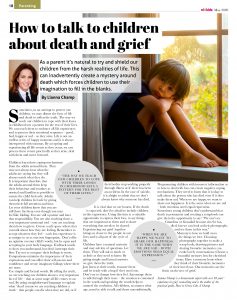How to talk to children about death and grief
How to talk to children about death and grief
As a parent it’s natural to try and shield our children from the harsh realities of life. This can inadvertently create a mystery around death which forces children to use their imagination to fill in the blanks. How to talk to children about death and grief
How to talk to children about death and grief By Lianna Champ, published in this May’s edition of parenting magazine Ni4Kids.
Sometimes, in an attempt to protect our children, we may distort the facts of life and death to soften the truth. The way we teach our children to cope with their losses in childhood sets a pattern for the rest of their lives. We can teach them to embrace all life experiences and to process their emotional responses – good, bad, happy or sad – as they arise. Life is not an endless series of happy moments and it is always interspersed with traumas. By accepting and experiencing all life events as they occur, we can process these events practically as they arise, deal with them and move forward.
Children learn their coping mechanisms from the adults around them. They may not always hear what the adults are saying but they will always watch what they do. It is important therefore that the adults around them keep their behaviour and routines as normal and familiar as possible to ensure the child feels safe. Adults can help children feel safe by giving them their full attention and time. Let your children know that you are still there for them even though you may feel like folding. You are still a parent and have that responsibility. You are also teaching them a very important emotional tool – you are teaching them how to grieve. Create a safe space where they can talk about how they are feeling. Remember to accept whatever they feel – each loss experience is as unique to us as our own fingerprint. Don’t offer an opinion on your child’s words, but be open and accepting in your body language. Feedback words to show you understand, but don’t interrupt their flow. Try not to compare their feelings to yours. Comparisons minimise the importance of their expressions and can affect their self-esteem and confidence and create imaginary failings where there are none.
“WHEN WE ARE HAPPY, WE WANT TO SHARE OUR HAPPINESS. IT IS THE SAME WHEN WE ARE SAD – BOTH EMOTIONS NEED EQUAL EXPRESSION.”
Use simple and factual words. By telling the truth, we are teaching our children about a very important fact of life – that at some stage all life comes to an end. By using straightforward language to explain what ‘dead’ means we are teaching children a truth – that people can die when they are old, or if their bodies stop working properly through illness or if there has been an accident. In the case of suicide, it is alright to admit that we don’t always know why someone has died.
It is vital that we are honest. If the death is expected, don’t be afraid to include children in this experience. Using this time is a valuable opportunity to express their love, to say things that are important to them and to share everything that needs to be shared. Experiencing our grief together brings us closer to the people in our lives and is all part of the cycle of life.
“THE WAY WE TEACH OUR CHILDREN TO COPE WITH THEIR LOSSES IN CHILDHOOD SETS A PATTERN FOR THE REST OF THEIR LIVES.”
Children have a natural curiosity and may ask lots of questions. Let them. They will ask as much or as little as they need to know. By giving simple and factual answers we give them the truth. Just listen to their words, reassure them and be ready with a hug if they need one. Don’t try to change how they feel. Encourage them to talk through their tears – the emotion is contained in the words and speaking the words helps to unravel the confusion.
All children, no matter what age, must be able to talk and share unconditionally. Programming children with incorrect information as to how to deal with loss can create negative coping mechanisms. They need to learn that it is okay to talk about the person who has died even if it does make them sad. When we are happy, we want to share our happiness. It is the same when we are sad – both emotions need equal expression. Sometimes young children don’t understand that death is permanent and creating a scrapbook can give them the opportunity to say: “We can’t see Grandma or Grandad because she/he has died, but we can look at their photographs and see them in this way.” Memory is how we hold on to the things we love. Choosing photographs together to make a scrap book, drawing pictures and sharing favourite memories can evoke lovely conversations. Choose a beautiful memory box for cherished items. Have a memory hour where they think of their favourite memories of their loved one. Our memories are the fruits on the tree of grief.
Lianna Champ is a bereavement expert with over 40 years’ experience in grief counselling and is the author of the practical guide, How to Grieve Like A Champ.

